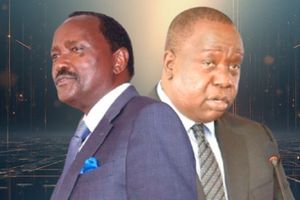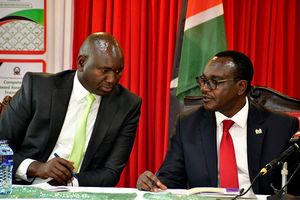Premium
How Njonjo, Gethi were embroiled in coup plot in Seychelles that embarrassed Moi

Attorney General Charles Njonjo (left) welcomes President Moi at KICC, Nairobi when he arrived to open an Interpol meeting. At the centre is Police Commissioner Ben Gethi.
What you need to know:
- It is now known that a French tourist, not part of the group but sandwiched between them and the last two, was found to have concealed a fruit in his bag. An officer ordered everyone to open their bags including the force bottoms for a thorough check.
- ‘Mad Mike', who had hoped to take over the radio station, the airport and the nearby army barracks early next morning, was quickly informed and a gun fight ensued.
- After ‘Mad Mike’ was arrested in South Africa, he was accused of kidnapping a pilot and no mercenary charges were brought.
- Back in Nairobi, the embarrassing saga saw President Moi write to President Rene to deny that his government was involved in the coup attempt.
The last time a Kenyan journalist tried to fly into Seychelles to follow the story of former President James Mancham, he was forced to remove his shoes, and ordered to squat on the floor as he awaited deportation orders.
And the orders came faster than he expected. He never passed the immigration desk and remains a persona non grata — to this day.
That was 11 years ago and that is how the Seychellois treat anyone arriving from Kenya on a mission to unravel the mystery of “The Boss” — as they still call the now-retired, shrewd and feline political operator, President Albert Rene.
There is a bitter story behind that saga and the Seychellois intelligence snoops on calls from Nairobi. It is a story that is well known in Kenyan political circles because it involved guns, espionage, mercenaries and a plot to overthrow President Rene.
680 HOTEL DRAMA
The drama started on the morning of November 5, 1981 at 680 Hotel — perhaps earlier — when a fugitive former Seychelles Cabinet minister Gerald Hoareau arrived.
He was soon followed by a businessman-turned-politician Paul Chow who stayed at the hotel between November 16 and 18.
The reason they had picked 680 Hotel is because they knew the then manager, the Austrian-born Gerry Saurer, who had previously been managing the prestigious Pirates Arms Hotel in Seychelle’s Victoria City and whose clientele included the arms-dealer and billionaire Adnan Khashoggi.
Gerry, perhaps, did not know about his guests’ mission — after all, he had arrived in Kenya to pursue his hospitality industry dream and his other passion — football. Besides the 680 Hotel job, he actually became Harambee Stars’ coach and took the team to the 1992 Cup of Nations in Senegal.
Back to the mercenaries, the two politicians stayed at 680 Hotel for only three days and vanished. It is not known for how long they remained in Nairobi.
What is known is that they were in town on behalf of deposed Seychelles President James Mancham, who they wanted to restore to power with the help of UK, Zimbabwe and South African mercenaries and that Kenya was part of the operation base.
"MAD MIKE"
Hoareau, who was assassinated on November 29, 1985 by an unidentified gunman on the doorsteps of his London home, was taken to the offices of SunBird Aviation at Wilson Airport where he booked a Beechcraft Super Kingair 2000, registration number N 821CA.
Sunbird Aviation, now AirKenya, was owned by Andrew Cole (later Lord Enniskileen), a former managing director of Kenya Airways, and a close ally of then powerful Attorney General Charles Njonjo and then Police Commissioner, Ben Gethi. In those days, Gethi and Njonjo’s words were law. They also had a shared value: penchant for secrecy. All they were required to do was to not interfere.
While the first plane was to fly out the mercenaries from Pretoria led by the infamous Col “Mad Mike” Hoare disguised as a rugby team, another was to fly Mancham and part of his exiled Cabinet back home if the coup turned successful.
Mancham and his group were to be in Mombasa disguised as American tourists: Mr and Mrs Morgan, Mr and Mrs SPC Bowman and a Mr Nescott.
Besides Gethi and Njonjo, another person who was privy to the arrangement was a former Deputy Director of Criminal Investigation Department, JD Irwin.
Also brought into the picture was a former Special Branch officer and Safari Rally chairman William Henry Parkinson; an Irishman residing in Kenya and a Captain David John Leonard. The last two had links with South Africa. The plane that was to fly Mancham belonged to Parkinson, and leased to Sunbird Aviation.
“Mad Mike”, like Parkinson, was Irish and was also in Nairobi for the final touches. By this time, he was the best known mercenary leader in Africa after his exploits in the Congo war where he had been hired in 1960s by Congolese Prime Minister Moise Tshombe to fight a revolt in Katanga.
"AMERICAN TOURISTS"
It was Parkinson who provided Sunbird Aviation with the fictitious names of “American Tourists” who were to be flown to Seychelles from Mombasa on the day of the coup.
Parkinson would later admit that he had been asked by Irwin to make arrangements to supply an aircraft capable of flying direct to Seychelles.
He was also told that this had the blessings of the Moi government. It is not clear whether the Moi government was directly involved though President Rene accused Njonjo and Gethi as the two senior Kenyans who helped the mercenaries.
ASSEMBLED IN NAIROBI
Back in Durban’s Hilton Hotel, the mercenary leader “Mad Mike” Hoare told a South African intelligence officer, Martin Dolinschek that Kenya had agreed to send “troops and police while the government-in-waiting was assembled in Nairobi”.
He showed him 60 brand new AK-47 assault rifles, three boxes of RPGs (rocket-propelled grenades) and 20 second-hand AK-47 from Romania.
After the guns were tested, at a disused quarry north of Durban, by Hoares’ sons, Chris and Simon, they were packed in bags which had false bottoms.
The Apartheid South African government, which was opposed to the communist government at Seychelles, had allowed Hoare to go ahead with his plans as long as he did not recruit most of his mercenaries from South Africa, which he, of course, ignored.
With all those approvals and assurances in Kenya and South Africa, ‘Mad Mike’ on November 25, 1981, chartered a Royal Swazi jet with his armed team disguised as members of Ancient Order of Froth Blowers, a beer-drinking club. Four mercenaries had already flown to the island with some arms.
“Kenyans were the ace in the pack,” one of the mercenaries later told a UN committee of inquiry.
The deadly entourage touched down at Pointe Larue International in a flight booked by Johannesburg’s Budget Tours.
In Nairobi, Parkinson and Sunbird Aviation had sought and received clearance from Civil Aviation Board to fly to Seychelles.
Everything at the Mahe Airport had gone smoothly as the “rugby players” went through the customs with minimal check.
A stroke of bad luck happened just as the last two were to be cleared.
It is now known that a French tourist, not part of the group but sandwiched between them and the last two, was found to have concealed a fruit in his bag. An officer ordered everyone to open their bags including the force bottoms for a thorough check.
THE DRAMA BEGAN
‘Mad Mike', who had hoped to take over the radio station, the airport and the nearby army barracks early next morning, was quickly informed and a gun fight ensued.
He ordered his men to fight and not surrender. There was no chance to summon the expected “Kenya army and police” which was only to arrive after ‘Mad Mike’ had secured the army barracks, the airport and the radio station.
As the fighting continued, the mercenaries got a chance to take off after they hijacked an Air India Boeing 707 flight 224 that had just landed.
They ordered the pilot to fly them to Durban, which he did, but in the confusion six mercenaries missed the flight including the South African spy, Martin Dolinchek.
After ‘Mad Mike’ was arrested in South Africa, he was accused of kidnapping a pilot and no mercenary charges were brought.
NATIONAL EMBARRASSMENT
Back in Nairobi, the embarrassing saga saw President Moi write to President Rene to deny that his government was involved in the coup attempt.
In a letter dated February 4, 1982, Moi told President Rene that neither Mancham nor Gerald Hoareau had been to Kenya.
“Our records show that the last time this man entered Kenya was during Mr Mancham’s period as president. It is possible that Mr Edward Raoul Hoareau, a Seychelloise who has lived in Kenya for over thirty-two years and currently the resident manager of the Nairobi Inter-Continental Hotel could have been mistaken for Mr Gerald Hoareau,” wrote Moi.
Moi had either been duped by the intelligence or was playing politics. He also insisted that the persons who hired the Beechcraft aircraft from Sunbird Aviation were “American tourists”.
Andrew Cole would later in a published interview admit that Sunbird flew Mad Mike Hoar into Seychelles.
“We did, but we didn’t know (they were mercenaries)…They registered as a rugby team.”
In Mombasa, Mancham and his group were waiting for final word as they rested in a hotel. According to documents from Civil Aviation Board and reports by the UN Inquiry, the plane was to leave for Comoros first on November 24 and return to Mombasa for another flight on November 26. But Comoros denied them entry.
NJONJO'S FALL
Had Dolincheck not been arrested in Seychelles, perhaps the Kenyan connection would never have surfaced. In his bag were details of the Kenyan flight and the persons involved. He was jailed for 20 years and his cover blown: His real name was Anton Lubic.
“If people become mercenaries because it was lucrative business, the penalty for their crimes must be heavy as the law allows,” said Seychelles’ Chief Justice Earle Seaton as he sentenced the mercenaries left behind.
This episode embarrassed Moi, who was the then chairman of OAU (Organisation of African Unity), and he was left to clear the diplomatic mess.
This would become one of his main grounds to form a Commission of Inquiry to bring down Njonjo.
The reasoning was, if Njonjo could plan a coup in another country, he could as well plan one against him at home.
It was the first time that Kenya had attempted a regime change in a foreign country.
Meanwhile, Gerard Hoareau is still buried in London in a zinc casket awaiting repatriation.
Mancham, 76, returned to Seychelles in 1990s and twice ran for President and lost to Rene.
The other coup-maker Paul Chow is the leader of Seychelles Democratic Party and South Africa paid a $3 million ransom to have the captured mercenaries freed.





